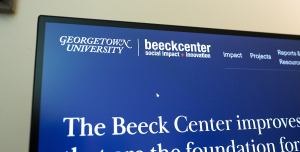Beeck Center dataset reveals digital ID verification practices for state benefits

The Beeck Center for Social Impact and Innovation at Georgetown University last week published a new dataset, showing the different technologies states use to verify the identities of people who apply online for public benefits.
The open dataset includes information about the applications for six public programs administered by states and territories — nutrition assistance, emergency cash, Medicaid, child care, unemployment insurance and assistance for women, infants and children. In total, the dataset features 158 different applications, though the researchers noted that many states have combined applications that allow residents to apply for multiple programs at once.
Ariel Kennan, a fellow with the Beeck Center’s Digital Benefits Network team, which developed the data, said in an interview that the project was inspired largely by COVID-era unemployment assistance and the unprecedented amount of fraudulent claims states have reported. In January of this year, the U.S. Government Accountability Office estimated that fraudulent pandemic unemployment insurance claims since April 2020 could top $60 billion across the country.
In response, Kennan said many states partnered with identity-proofing companies, like ID.me, to begin using facial recognition to verify benefits applications. In some instances, this created additional problems when applicants either didn’t have a state-issued ID for the software to compare against a selfie, or if they encountered well-documented errors in facial-recognition algorithms that misidentify people of color.
Kennan told StateScoop she discussed these issues with state officials.
“I said, ‘Do you all know what’s happening in other states? Is there a forum or a place to go for this information?’,” she said. “And they’re all saying, ‘No, but we’d really like to know what’s going on in other states.'”
To pull together the data, Elizabeth Bynum Sorrell, a researcher on the Digital Benefits Network team, said she and Kennan began seeking out publicly available information on state benefit systems to avoid filling out dummy applications that might trigger fraud alerts.
They also worked with Code for America, and built on some of the work the civic-tech nonprofit did for its Benefits Enrollment Field Guide.
Bynum Sorrell said the team was most interested in the entire identity-proofing process for benefits applications, including what documents applicants were required to submit and how personal information was used to authenticate an identity. Beyond the complications associated with facial recognition, other documentation requirements — like an email address or state-agency account — can make an application process much more difficult, she said.
“It could complicate what might have been a more simple registration process in the past, if that makes sense,” Bynum Sorrell said. “And we did find a good number of applications where identity-proofing steps on the front end were optional, so a user was either able to immediately skip the prompt. Or, if they were not able to successfully get verified through that process, they could still continue with the online application process, which we thought was a really interesting way of incorporating that.”
Keenan and Bynum Sorrell both acknowledged the dataset is not complete, and is missing some information about verification processes that were not available publicly. They’ve encouraged state benefits agencies to contact them about any inaccuracies or unknown fields in the set.
“Generally, we want this to be a resource for the ecosystem, not just us saying we learned some stuff, and here’s what we found,” Bynum Sorrell said. “We really wanted to publish this openly, because we want people to be able to engage with it deeply to use it in new ways to extend this work. And we’re really excited to hear from folks in the ecosystem to help us like keep building this out.”




